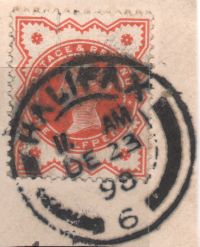Loading map...
{"minzoom":false,"maxzoom":false,"mappingservice":"leaflet","width":"auto","height":"450px","centre":false,"title":"","label":"","icon":"","lines":[],"polygons":[],"circles":[],"rectangles":[],"copycoords":false,"static":false,"zoom":13,"defzoom":14,"layers":["OpenStreetMap"],"image layers":[],"overlays":[],"resizable":false,"fullscreen":false,"scrollwheelzoom":true,"cluster":false,"clustermaxzoom":20,"clusterzoomonclick":true,"clustermaxradius":80,"clusterspiderfy":true,"geojson":"","clicktarget":"","imageLayers":[],"locations":[{"text":"\u003Cdiv class=\"mw-parser-output\"\u003E\u003Cp\u003EPost Office Winding Road now a Hotel\n\u003C/p\u003E\u003C/div\u003E","title":"Post Office Winding Road now a Hotel\n","link":"","lat":53.72438423310581,"lon":-1.8563309903901346,"icon":"/w/images/f/f8/Yellow_marker.png"},{"text":"\u003Cdiv class=\"mw-parser-output\"\u003E\u003Cp\u003ESite of the original Cheapside Receiving House\n\u003C/p\u003E\u003C/div\u003E","title":"Site of the original Cheapside Receiving House\n","link":"","lat":53.72273896021019,"lon":-1.8611836768708265,"icon":"/w/images/a/a0/Grey_marker.png"},{"text":"\u003Cdiv class=\"mw-parser-output\"\u003E\u003Cp\u003E1819 Silver street site of 1st post office\n\u003C/p\u003E\u003C/div\u003E","title":"1819 Silver street site of 1st post office\n","link":"","lat":53.722909056834744,"lon":-1.8625961572521572,"icon":"/w/images/a/a0/Grey_marker.png"},{"text":"\u003Cdiv class=\"mw-parser-output\"\u003E\u003Cp\u003E1822 6 Westgate Post Office\n\u003C/p\u003E\u003C/div\u003E","title":"1822 6 Westgate Post Office\n","link":"","lat":53.72153410562093,"lon":-1.8594950569252964,"icon":"/w/images/a/a0/Grey_marker.png"},{"text":"\u003Cdiv class=\"mw-parser-output\"\u003E\u003Cp\u003E1850 6 George Street office\n\u003C/p\u003E\u003C/div\u003E","title":"1850 6 George Street office\n","link":"","lat":53.72233914555423,"lon":-1.8622680155608018,"icon":"/w/images/a/a0/Grey_marker.png"},{"text":"\u003Cdiv class=\"mw-parser-output\"\u003E\u003Cp\u003EHalifax GPO Commercial Street\n\u003C/p\u003E\u003C/div\u003E","title":"Halifax GPO Commercial Street\n","link":"","lat":53.722109924891214,"lon":-1.8613276974642916,"icon":"/w/images/a/a0/Grey_marker.png"},{"text":"\u003Cdiv class=\"mw-parser-output\"\u003E\u003Cp\u003ECurrent town Post Office instore WHSmith 5 Market Street\n\u003C/p\u003E\u003C/div\u003E","title":"Current town Post Office instore WHSmith 5 Market Street\n","link":"","lat":53.72303748680965,"lon":-1.8588651089357602,"icon":"/w/images/f/f8/Yellow_marker.png"},{"text":"\u003Cdiv class=\"mw-parser-output\"\u003E\u003Cp\u003ERoyal Mail Halifax Delivery \u0026amp; Sorting Office Gaol Lane\n\u003C/p\u003E\u003C/div\u003E","title":"Royal Mail Halifax Delivery \u0026amp; Sorting Office Gaol Lane\n","link":"","lat":53.724233961002085,"lon":-1.8574496120531876,"icon":"/w/images/a/af/Red_marker.png"},{"text":"\u003Cdiv class=\"mw-parser-output\"\u003E\u003Cp\u003EBell Hall\n\u003C/p\u003E\u003C/div\u003E","title":"Bell Hall\n","link":"","lat":53.71471857714528,"lon":-1.8728673163207288,"icon":""},{"text":"\u003Cdiv class=\"mw-parser-output\"\u003E\u003Cp\u003EBoothtown\n\u003C/p\u003E\u003C/div\u003E","title":"Boothtown\n","link":"","lat":53.734710976047104,"lon":-1.8653888764030082,"icon":""},{"text":"\u003Cdiv class=\"mw-parser-output\"\u003E\u003Cp\u003ECalifornia\n\u003C/p\u003E\u003C/div\u003E","title":"California\n","link":"","lat":53.724678447650874,"lon":-1.8737108180842632,"icon":""},{"text":"\u003Cdiv class=\"mw-parser-output\"\u003E\u003Cp\u003ECopley\n\u003C/p\u003E\u003C/div\u003E","title":"Copley\n","link":"","lat":53.69859829308675,"lon":-1.8729465586664489,"icon":""},{"text":"\u003Cdiv class=\"mw-parser-output\"\u003E\u003Cp\u003ECote Hill\n\u003C/p\u003E\u003C/div\u003E","title":"Cote Hill\n","link":"","lat":53.72025054926126,"lon":-1.9018413447249336,"icon":""},{"text":"\u003Cdiv class=\"mw-parser-output\"\u003E\u003Cp\u003EDunkirk\n\u003C/p\u003E\u003C/div\u003E","title":"Dunkirk\n","link":"","lat":53.71671039546717,"lon":-1.889316313080878,"icon":""},{"text":"\u003Cdiv class=\"mw-parser-output\"\u003E\u003Cp\u003EGibbert Street\n\u003C/p\u003E\u003C/div\u003E","title":"Gibbert Street\n","link":"","lat":53.7227416399626,"lon":-1.8818658645565682,"icon":""},{"text":"\u003Cdiv class=\"mw-parser-output\"\u003E\u003Cp\u003EHaley Hill\n\u003C/p\u003E\u003C/div\u003E","title":"Haley Hill\n","link":"","lat":53.73101704469619,"lon":-1.863624488408935,"icon":""},{"text":"\u003Cdiv class=\"mw-parser-output\"\u003E\u003Cp\u003EHeath\n\u003C/p\u003E\u003C/div\u003E","title":"Heath\n","link":"","lat":53.710276532680396,"lon":-1.8611795579271284,"icon":""},{"text":"\u003Cdiv class=\"mw-parser-output\"\u003E\u003Cp\u003EHigh Road Well\n\u003C/p\u003E\u003C/div\u003E","title":"High Road Well\n","link":"","lat":53.725739833894046,"lon":-1.9018063075441147,"icon":""},{"text":"\u003Cdiv class=\"mw-parser-output\"\u003E\u003Cp\u003EHopwood Lane\n\u003C/p\u003E\u003C/div\u003E","title":"Hopwood Lane\n","link":"","lat":53.72082755243652,"lon":-1.8786972605925119,"icon":""},{"text":"\u003Cdiv class=\"mw-parser-output\"\u003E\u003Cp\u003EIllingworth\n\u003C/p\u003E\u003C/div\u003E","title":"Illingworth\n","link":"","lat":53.75918805879963,"lon":-1.8934820821749776,"icon":""},{"text":"\u003Cdiv class=\"mw-parser-output\"\u003E\u003Cp\u003EKing Cross\n\u003C/p\u003E\u003C/div\u003E","title":"King Cross\n","link":"","lat":53.71561807272131,"lon":-1.8800781062448904,"icon":""},{"text":"\u003Cdiv class=\"mw-parser-output\"\u003E\u003Cp\u003EKing Cross Street\n\u003C/p\u003E\u003C/div\u003E","title":"King Cross Street\n","link":"","lat":53.71827063140415,"lon":-1.8736678548707546,"icon":""},{"text":"\u003Cdiv class=\"mw-parser-output\"\u003E\u003Cp\u003ELee Mount\n\u003C/p\u003E\u003C/div\u003E","title":"Lee Mount\n","link":"","lat":53.73256864233097,"lon":-1.8738971013548333,"icon":""},{"text":"\u003Cdiv class=\"mw-parser-output\"\u003E\u003Cp\u003EMount Pellon\n\u003C/p\u003E\u003C/div\u003E","title":"Mount Pellon\n","link":"","lat":53.72610388794154,"lon":-1.889505491825227,"icon":""},{"text":"\u003Cdiv class=\"mw-parser-output\"\u003E\u003Cp\u003ENew Bank\n\u003C/p\u003E\u003C/div\u003E","title":"New Bank\n","link":"","lat":53.727858098592314,"lon":-1.8540804141488083,"icon":""},{"text":"\u003Cdiv class=\"mw-parser-output\"\u003E\u003Cp\u003ENorth Bridge\n\u003C/p\u003E\u003C/div\u003E","title":"North Bridge\n","link":"","lat":53.72710314539708,"lon":-1.85972157194315,"icon":""},{"text":"\u003Cdiv class=\"mw-parser-output\"\u003E\u003Cp\u003EOvenden\n\u003C/p\u003E\u003C/div\u003E","title":"Ovenden\n","link":"","lat":53.742883631733235,"lon":-1.880254545904294,"icon":""},{"text":"\u003Cdiv class=\"mw-parser-output\"\u003E\u003Cp\u003EPellon Lane\n\u003C/p\u003E\u003C/div\u003E","title":"Pellon Lane\n","link":"","lat":53.72931475771685,"lon":-1.886838916518536,"icon":""},{"text":"\u003Cdiv class=\"mw-parser-output\"\u003E\u003Cp\u003EQueen's Road\n\u003C/p\u003E\u003C/div\u003E","title":"Queen's Road\n","link":"","lat":53.72046463974945,"lon":-1.8816441299912454,"icon":""},{"text":"\u003Cdiv class=\"mw-parser-output\"\u003E\u003Cp\u003ESt. Albans Road\n\u003C/p\u003E\u003C/div\u003E","title":"St. Albans Road\n","link":"","lat":53.70813657088687,"lon":-1.858146505289137,"icon":""},{"text":"\u003Cdiv class=\"mw-parser-output\"\u003E\u003Cp\u003ESt. James's Road\n\u003C/p\u003E\u003C/div\u003E","title":"St. James's Road\n","link":"","lat":53.72529610737101,"lon":-1.8633767492047764,"icon":""},{"text":"\u003Cdiv class=\"mw-parser-output\"\u003E\u003Cp\u003ESalterhebble (Now Park Lane PO)\n\u003C/p\u003E\u003C/div\u003E","title":"Salterhebble (Now Park Lane PO)\n","link":"","lat":53.69997776458285,"lon":-1.8509451455089452,"icon":""},{"text":"\u003Cdiv class=\"mw-parser-output\"\u003E\u003Cp\u003EScar Bottom\n\u003C/p\u003E\u003C/div\u003E","title":"Scar Bottom\n","link":"","lat":53.68683075218941,"lon":-1.8837147605937323,"icon":""},{"text":"\u003Cdiv class=\"mw-parser-output\"\u003E\u003Cp\u003EShaw Syke\n\u003C/p\u003E\u003C/div\u003E","title":"Shaw Syke\n","link":"","lat":53.71604536502578,"lon":-1.857149013434185,"icon":""},{"text":"\u003Cdiv class=\"mw-parser-output\"\u003E\u003Cp\u003ESiddal\n\u003C/p\u003E\u003C/div\u003E","title":"Siddal\n","link":"","lat":53.708465928000884,"lon":-1.8496039607735886,"icon":""},{"text":"\u003Cdiv class=\"mw-parser-output\"\u003E\u003Cp\u003EThrum Hall\n\u003C/p\u003E\u003C/div\u003E","title":"Thrum Hall\n","link":"","lat":53.7226792918488,"lon":-1.8820479766729399,"icon":""},{"text":"\u003Cdiv class=\"mw-parser-output\"\u003E\u003Cp\u003EUnion Street\n\u003C/p\u003E\u003C/div\u003E","title":"Union Street\n","link":"","lat":53.71948227137835,"lon":-1.8577788924576044,"icon":""},{"text":"\u003Cdiv class=\"mw-parser-output\"\u003E\u003Cp\u003EWarley\n\u003C/p\u003E\u003C/div\u003E","title":"Warley\n","link":"","lat":53.71986878687319,"lon":-1.9141947503704038,"icon":""},{"text":"\u003Cdiv class=\"mw-parser-output\"\u003E\u003Cp\u003EWheatley\n\u003C/p\u003E\u003C/div\u003E","title":"Wheatley\n","link":"","lat":53.73613779777029,"lon":-1.8933615058193658,"icon":""}],"imageoverlays":null}
Halifax is a minster town in the Metropolitan Borough of Calderdale in West Yorkshire, England. Historically in the West Riding of Yorkshire, the town has been a centre of woollen manufacture from the 15th century onward, originally dealing through the Piece Hall.
The town's name was recorded in about 1091 as Halyfax, from the Old English halh-gefeaxe, meaning "area of coarse grass in the nook of land". This explanation is preferred to derivations from the Old English halig (holy), in hālig feax or "holy hair", proposed by 16th-century antiquarians. The incorrect interpretation gave rise to two legends. One concerned a maiden killed by a lustful priest whose advances she spurned. Another held that the head of John the Baptist was buried here after his execution. The legend is almost certainly medieval rather than ancient, although the town's coat of arms carries an image of the saint. Another explanation is a corruption of the Old English hay and ley a clearing or meadow. This etymology is based on Haley Hill, the nearby hamlet of Healey (another corruption), and the common occurrence of the surnames Hayley/Haley around Halifax. The erroneous derivation from halig has given rise to the demonym Haligonian, which is of recent origin and not in universal use.
Halifax is not mentioned in the Domesday Book, and evidence of the early settlement is indefinite. By the 12th century the township had become the religious centre of the vast parish of Halifax, which extended from Brighouse in the east to Heptonstall in the west. Halifax Minster, parts of which date from the 12th century is dedicated to St John the Baptist. The minster's first organist, in 1766, was William Herschel, who discovered the planet Uranus. The coat of arms of Halifax include the chequers from the original coat of arms of the Earls Warenne, who held the town during Norman times.
Halifax was notorious for its gibbet, an early form of guillotine used to execute criminals by decapitation, that was last used in 1650. A replica has been erected on the original site in Gibbet Street. Its original blade is on display at Bankfield Museum. Punishment in Halifax was notoriously harsh, as remembered in the Beggar's Litany by John Taylor (1580–1654), a prayer whose text included "From Hull, from Halifax, from Hell, ‘tis thus, From all these three, Good Lord deliver us.".
The town's 19th-century wealth came from the cotton, wool and carpet industries and like most other Yorkshire towns, it had a large number of weaving mills many of which have been lost or converted to alternate use.
Halifax is known for Mackintosh's chocolate and toffee products including Rolo and Quality Street.
The Halifax Bank was also founded and is still headquartered in Halifax.
Prior to Halifax having a Post Office it had a receiving house in Cheapside in the town centre, this was a small windowed building with no public access. People would call at the window for receiving mail for them; or for the posting of mail. As the town and businesses grew this was deemed too small and a functional Post Office was needed. Halifax 'original post office' (now a hotel) was on (55) Winding Road in the town centre.
By 1819, the Post Office moved to a building opposite the ‘White Lion’ in Silver Street, but by 1822 it had moved again to to 6 Westgate.
By 1850 further expansion in volume of mail rendered the town needing even larger offices. These were obtained in 1851 at George Street (No. 6).
Further growth and more space were again needed by 1863 and premises were aqcuired further down George Street, thought to be Number 3.
Finally the GPO agreed to build a purpose built GPO in the town that would sustain a future for growth this was built around the corner on Commercial Street. This was completed in 1887. The office finally closed in 2016 and re-opened within a WHSmith store at 5 Market Street in the town.
In 1840 the Postmistress Tabitha Bagnold when the uniform peny postage was introduced. The Post office was on Windhill Lane (now called Winding Road).






